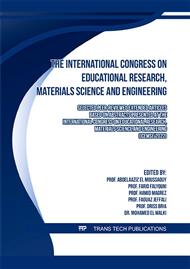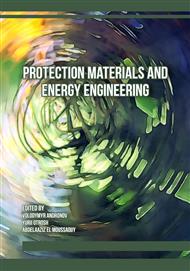[1]
Hssaisoune, M., Bouchaou, L., Sifeddine, A., Bouimetarhan, I., & Chehbouni, A. (2020). Moroccan groundwater resources and evolution with global climate changes. Geosciences, 10(2), 81.
DOI: 10.3390/geosciences10020081
Google Scholar
[2]
R assam, A., Chaouch, A., Bourkhiss, B., & Bourkhiss, M. B. (2012). Performances de la dégradation de la matière organique par lagunage aéré dans la station d'épuration des eaux usées de la ville d'Oujda (Maroc oriental). Bulletin in la Société Royale des Sciences de Liège.
DOI: 10.25518/0037-9565.10218
Google Scholar
[3]
Abdouni, A. E., Bouhout, S., Merimi, I., Hammouti, B., & Haboubi, K. (2021). Physicochemical characterization of wastewater from the Al-Hoceima slaughterhouse in Morocco. Caspian Journal of Environmental Sciences, 19(3), 423-429.
Google Scholar
[4]
L.Burgaud « wastewater in dairy industry. » 10.1051, 1969.
Google Scholar
[5]
Alewi, H. K., Abood, E. A., & Ali, G. (2022). An inquiry into the relationships between BOD5, COD, and TOC in Tigris River, Maysan Province, Iraq. Caspian Journal of Environmental Sciences, 20(1), 37-43.
Google Scholar
[6]
Moletta.R, & Torrijos.M (2001), traitement des effluents de la filière laitière. Techniques de l'Ingénieur, agroalimentaire F1501, 2001.
DOI: 10.51257/a-v1-f1501
Google Scholar
[7]
Canler, J. P., & Perret, J. M. (2004). La clarification: approche dimensionnelle basée sur le couple aération-clarification. Fondements et évolutions. In 83 ème Congrès ASTEE, Aix-les-Bains, 24-28 mai 2004 (p.15).
Google Scholar
[8]
Ahmad, T., Aadil, R. M., Ahmed, H., ur Rahman, U., Soares, B. C., Souza, S. L., ... & Cruz, A. G. (2019). Treatment and utilization of dairy industrial waste: A review. Trends in Food Science & Technology, 88, 361-372.
DOI: 10.1016/j.tifs.2019.04.003
Google Scholar
[9]
Awaleh, M. O., & Soubaneh, Y. D. (2014). Waste water treatment in chemical industries: the concept and current technologies. Hydrology: Current Research, 5(1), 1.
Google Scholar
[10]
Rajasulochana, P., & Preethy, V. (2016). Comparison on efficiency of various techniques in treatment of waste and sewage water–A comprehensive review. Resource-Efficient Technologies, 2(4), 175-184.
DOI: 10.1016/j.reffit.2016.09.004
Google Scholar
[11]
Mottot, Y. (1999). Coagulants et floculants. In 279th Conference of l'Université de tous les savoirs.
Google Scholar
[12]
J. Boeglin, Propriétés des eaux naturelles. Techniques de l'Ingénieur, traitement de l'Environnement : Nancy, 2001, ISSN : 1776-0135, G1250.
DOI: 10.51257/a-v1-g1110
Google Scholar
[13]
Khnaijer, B., Cherkaoui, E., Khamar, M., & Nounah, A. (2020). Characterization of the residual sludge from the wastewater treatment plant of JERADA. In E3S Web of Conferences (Vol. 150, p.02004). EDP Sciences.
DOI: 10.1051/e3sconf/202015002004
Google Scholar
[14]
Kristensen, E., Ahmed, S. I., & Devol, A. H. (1995). Aerobic and anaerobic decomposition of organic matter in marine sediment: which is fastest?. Limnology and oceanography, 40(8), 1430-1437.
DOI: 10.4319/lo.1995.40.8.1430
Google Scholar
[15]
Gregorich, E. G., Beare, M. H., Stoklas, U., & St-Georges, P. (2003). Biodegradability of soluble organic matter in maize-cropped soils. Geoderma, 113(3-4), 237-252.
DOI: 10.1016/s0016-7061(02)00363-4
Google Scholar
[16]
Gupta, S.K., & Sharma, R. (1996). Biological oxidation of high strength nitrogenous wastewater. Water Research, 30(3), 593-600.
DOI: 10.1016/0043-1354(95)00172-7
Google Scholar
[17]
Choubert, J. M. (2002). Analysis and Optimization of Nitrogen Treatment by Activated Sludge Low Temperature (Doctoral dissertation, Doctoral Thesis, University Louis Pasteur‒Strasbourg I, France).
Google Scholar
[18]
Akpor, O.B., & Muchie, M. (2010). Bioremediation of polluted wastewater influent: Phosphorus and nitrogen removal. Scientific Research and Essays, 5(21), 3222-3230.
Google Scholar
[19]
Tosoni, J. (2015). Compréhension des facteurs de contrôle des performances de la déshydratation mécanique des boues résiduaires en filtre-presse (Doctoral dissertation, Clermont-Ferrand 2).
Google Scholar
[20]
Insel, G., Dagdar, M., Dogruel, S., Dizge, N., Cokgor, E.U., & Keskinler, B. (2013). Biodegradation characteristics and size fractionation of landfill leachate for integrated membrane treatment. Journal of hazardous materials, 260, 825-832.
DOI: 10.1016/j.jhazmat.2013.06.037
Google Scholar
[21]
Tixier, N., Guibaud, G., & Baudu, M. (2003). Determination of some rheological parameters for the characterization of activated sludge. Bioresource Technology, 90(2), 215-220.
DOI: 10.1016/s0960-8524(03)00109-3
Google Scholar
[22]
Smith, A. L., & Greenberg, A. E. (1963). Evaluation of methods for determining suspended solids in wastewater. Journal (Water Pollution Control Federation), 940-943.
Google Scholar
[23]
Bradley, R. L. (2010). Moisture and total solids analysis. In Food analysis (pp.85-104). Springer, Boston, MA.
Google Scholar
[24]
El Hammoudani, Y., & Dimane, F. (2021). Occurrence and fate of micropollutants during sludge treatment: Case of Al-Hoceima WWTP, Morocco. Environmental Challenges, 5, 100321.
DOI: 10.1016/j.envc.2021.100321
Google Scholar




